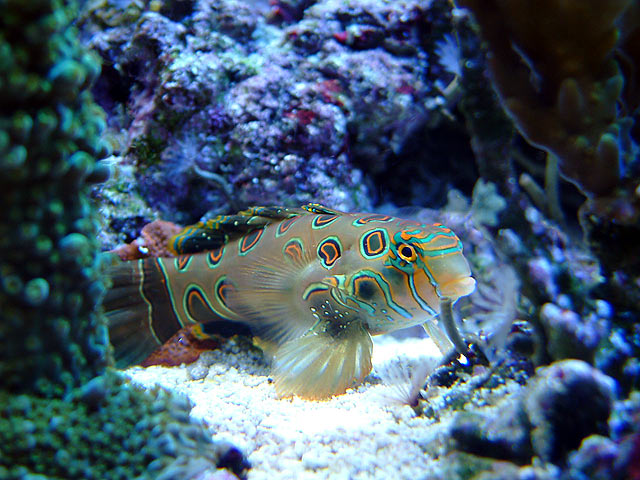These palys are nicknamed Utter Chaos
Serpent starfish come in a few different colors and styles, and all of them are a good choice as part of your cleanup crew. They will retreat into the rockwork most of the time, but surely will be seen when food hits the water. This banded starfish has been with me for more than six years. I have a pair of tan-brown ones since 2004, so 14 years at the time of this entry. They don't prey on fish or other invertebrates, and help keep the surface sand devoid of waste. I'd recommend one in a 30-60g tank.
Quite a bit of sponge growth in our tank is unplanned, coming in as a hitchhiker on the rockwork. If you have some, take some time to enjoy its design, its texture. Remember that sponge will not survive out of water, so if you remove the rock from your tank for any time at all, it will die and can cause an ammonia spike in your system.
Because of the shape of this coral, I had to buy it. A few people helped me identify it as Psammacora. The bright green coloration, as well as the fuzzy polyps, really caught my eye. And in the core of this colony, a number of barnacles extend whiskers for filter feeding. It is a nice coral with great texture.
This Gorgonian - Pseudoplexaura sp. - was acquired from the 20,000g reef in Long Island back in 2012, and has been growing steadily for years. Occasionally I'll frag a small piece to share with a special hobbyist. This species is easy to keep; it's photo-synthetic meaning it does need light to feed, but I never target feed it any foods directly. Clearly it captures what it needs on its own, since it is doing so well in my system.
Rotifers are pretty much the smallest food hobbyists can grow, and you'll need a starter culture which is available online from Florida Aqua Farms. Rotifers are tiny specks of dust basically. In the image above, there are hundreds if not a few thousand rotifers that gathered along the edge of a petri-dish. Video would have been a better choice as they are just too small for my camera to photograph accurately. Rotifers need phytoplankton to live, and this must be provided daily.
One of the blights of many SPS keepers has been the notorious red bugs, which aren't even red! These tiny fleas are yellow and tend to congregate on smooth Acropora colonies. They are tough to kill, using a prescription product called Interceptor from your local vet. Please refer to Reef Central as well as this link for instructions on dosing this product, as it is quite an endeavor that has to be repeated three times and which may affect pods and crabs in your tank.
I got this Chalice in a trade from another hobbyist years ago, but don't recall the name. It's a beauty, and I enjoy looked at it especially at night when the actinic XHOs are running. It's orange skinned with yellow mouths, and contrasts with the green chalice behind it. Chalice corals are slow encrusting corals. If you try to frag them, then often break as easily as if you were trying to share a potato chip. Ideally, leave it alone and enjoy what you have is my motto.
I bought this Target or Spotted Mandarin - Synchiropus picturatus - to help consume and remove flatworms from my 55 gallon reef. Unfortunately, this fish doesn't seem to find them the least bit appetizing. However, it has found plenty of other food to eat, including prepared foods and even pellet food. Although it is a slow moving fish, it is extremely elusive when I try to photograph it. Reef-safe.

The porcelain crab is commonly found in tropical oceans. It has a flat round body, and come in a few different colors. Their two large claws are nothing to fear; these are timid reef-safe crabs. Often found in the rock work or under the rocks, you can see these scavengers seeking food as well as protection.











